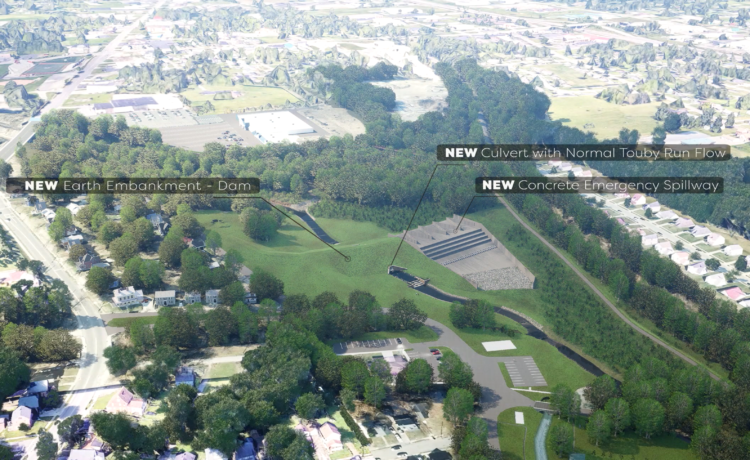MANSFIELD — A proposed $28 million dry dam that could remove 106 acres of the city’s north side from the flood plain will likely never be built with just local funds.
However, planning for the Touby Run Flood Mitigation Project, which began with discussions seven years ago, is finally ready for federal grant consideration, according to city engineer Bob Bianchi.
“We are getting to the point on the Touby Run dam project where it’s time to go after some major funding to help the city build and construct the project,” he told the Board of Control on Tuesday morning.
In turn, the board gave its approval for a $40,517 contract with a company to help prepare a federal grant application.
Bianchi said the city will seek a Building Resilient Infrastructure and Communities grant through the Federal Emergency Management Agency that could cover 90 percent of the project’s construction costs.
Rough math, based on a $28 million dry dam, translates to a grant that would equal approximately $25.2 million.
The dry dam, projected to be 900 feet long and 35 feet high at its tallest point, would help save the north end from the kind of massive high water experienced in 2007 — when a flood created an estimated $290 million in damages.
It would also create the potential for economic redevelopment in an area that requires expensive flood insurance and has long been largely ignored by developers.
In addition to removing 106 acres from the flood plain, Bianchi said it would “significantly” reduce flooding hazards in other nearby areas.
“There might be an instance where there’s four feet of flooding now, but there’s six inches after it’s built. Since there’s six inches, it would still be in the flood plain, but the hazard is greatly reduced,” the engineer said.

Mayor Jodie Perry called the dry dam project a “potential game changer for the City of Mansfield, not just for downtown, but for the north end as a whole.
“There have been residents there who have had to leave their homes over the years because they got flooded so much. There are still people living there that, if it floods again, are going to be impacted by that.
“I think that part of downtown from near the railroad tracks up to the bottom of the hill at Fifth (Street) … we’re not seeing a lot of investment there because of the flooding … the persistent flooding issues,” the mayor said.
“Is it gonna change everything overnight? No, but I think it certainly makes investments possible in a way that just doesn’t make any fiscal sense at the moment,” Perry said.
The city has worked with the Columbus-based development company EMHT on the project’s design for the last three years. Over the last 18 months Mansfield leaders have been in discussions with the Ohio Department of Natural Resources, the Environmental Protection Agency, the U.S. Army Corps of Engineers and the U.S. Fish & Wildlife Service.
EMHT was awarded a $1.5 million contract in 2022 to design the dam project, and received an additional $72,770 in 2023 to help prepare the project for FEMA consideration.
The dam would be built at the west end of North Lake Park, including a concrete spillway.
“We’ve spent some time looking at who can help us write the most dynamic, competitive (and) compelling grant application there is. We found this company, ICF, who has written many of these applications and they’ve been successful,” Bianchi said.
(Below is a PDF file showing the ICF Inc. dry dam proposal to the City of Mansfield.)
ICF Inc. is a consulting company founded in 1969 and is headquartered in Reston, Va., outside of Washington, D.C.
“BRIC is a nationally funded program that is competitive amongst all 50 states,” Bianchi said.
He said ICF has successfully guided other communities to BRIC awards in the past.
In an Aug. 23 letter to Bianchi, ICF contracts manager Andrew Wilson said the company has helped to obtain more than $210 million in FEMA funding for clients, including the BRIC program.
“The current federal funding landscape for pre-disaster resilience presents an ideal opportunity for (Mansfield) to capture a BRIC grant for its Touby Run Flood Mitigation Project,” Wilson wrote.
“ICF can offer expert technical assistance and guidance across the BRIC application development process,” he wrote.

Bianchi told the Board of Control the application process will take a great deal of time and effort.
“It’s going to be a lot of work on our end (and) their end, of course. They’re going to kind of guide and steer the ship based on what they’ve seen work in the past and what they haven’t seen work,” Bianchi said.
The BRIC grant application must be submitted to the state EMA for review in November to reach the federal government in February.
According to its website, in July, FEMA announced 56 projects from the national BRIC competition, totaling $674.5 million. These projects were selected in all 10 FEMA regions and are in 22 states and the District of Columbia.
Bianchi compared the BRIC application to the $7.3 million federal grant the city obtained for its North Main Street Corridor Improvement project.
“This is similar in how we engaged the consultant to help us. We’re going to put everything we’ve got into this. If we are not successful, we have a baseline … we have the foundation of all the grant documentation … and we will then apply again the following year,” he said.
“After some of the meetings I have been in, there’s going to be a lot involved,” Bianchi said.
Costs have gone up, largely due to inflation, since the plan was first discussed several years ago when the estimate was around $15.5 million.
“Plus, ODNR is requiring some things that we didn’t think necessarily needed to be done, but they are the ones who write the permit. So there’s a few things that added cost with their review,” Bianchi said in April.
He said there will also be costs associated with wetlands mitigation required by the EPA.

















